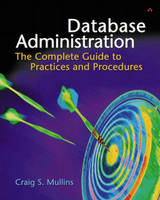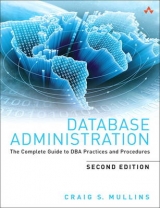
Database Administration
Addison Wesley (Verlag)
978-0-201-74129-2 (ISBN)
- Titel erscheint in neuer Auflage
- Artikel merken
The first platform-independent guide to the discipline of database administration, this book presents best practices and procedures that apply to any database platform: Oracle, Microsoft, IBM, Sybase, even MySQL and Postgres. It will be an ideal resource for organizations that have deployed multiple databases -- and for professionals who want to move comfortably amongst database platforms. Craig Mullins begins with an up-to-date introduction to the field of database administration, outlining a broad range of DBA roles and responsibilities, and showing how evolving technology has changed the profession. He walks through creating the database environment; data modeling and normalization; database/application design; and change management. Next, he introduces best practices for maximizing availability, security, data integrity, and all aspects of system, database, and application performance. From data warehouse administration to Web-based data access, Database Administration: Practices and Procedures is a single source for authoritative guidance on every facet of database administration. For every database administrator, and for managers responsible for supervising database administrators.
Craig S. Mullins is a data management strategist for BMC Software. Craig has more than fifteen years of experience in all facets of database systems development, including developing and teaching DB2 and SQL Server classes, systems analysis and design, database and system administration, and data analysis. He has used DB2 for OS/390 since Version 1 and has experience with Oracle, Sybase, and Microsoft SQL Server. Craig has worked as a DBA, developer, instructor, and analyst in multiple industries. 0201741296AB05142002
(NOTE: Most chapters conclude with Summary, Review, Bonus Question and Suggested Reading.)
Preface.
How to Use This Book.
Acknowledgments.
About the Author.
1. What Is a DBA?
The DBA: Revered or Reviled?
Why Learn Database Administration?
A Unique Vantage Point.
DBA Salaries.
Database Technology.
The Management Discipline of Database Administration.
A Day in the Life of a DBA.
Evaluating a DBA Job Offer.
Database, Data, and System Administration.
Data Administration.
Database Administration.
System Administration.
DBA Tasks.
Database Design.
Performance Monitoring and Tuning.
Availability.
Database Security and Authorization.
Backup and Recovery.
Data Integrity.
DBMS Release Migration.
Jack-of-All-Trades.
Types of DBAs.
System DBA.
Database Architect.
Database Analyst.
Data Modeler.
Application DBA.
Task-Oriented DBA.
Data Warehouse Administrator.
Staffing Considerations.
How Many DBAs?
DBA Reporting Structures.
Multiplatform DBA Issues.
Test and Production.
New Technology and the DBA.
Procedural DBAs: Managing Database Logic.
The Internet: From DBA to e-DBA.
The PDA DBA.
DBA Certification.
The Rest of the Book.
2. Creating the Database Environment.
Defining the Organization's DBMS Strategy.
Choosing a DBMS.
DBMS Architectures.
DBMS Clustering.
DBMS Proliferation.
Hardware Issues.
Installing the DBMS.
DBMS Installation Basics.
Hardware Requirements.
Storage Requirements.
Memory Requirements.
Configuring the DBMS.
Connecting the DBMS to Supporting Infrastructure Software.
Installation Verification.
DBMS Environments.
Upgrading DBMS Versions and Releases.
Features and Complexity.
Complexity of the DBMS Environment.
Reputation of the DBMS Vendor.
Support Policies of the DBMS.
Organization Style.
DBA Staff Skill Set.
Platform Support.
Supporting Software.
Fallback Planning.
Migration Verification.
The DBMS Upgrade Strategy.
Database Standards and Procedures.
Database Naming Conventions.
Other Database Standards and Procedures.
DBMS Education.
3. Data Modeling and Normalization.
Data Modeling Concepts.
Entity-Relationship Diagramming.
The Components of a Data Model.
Entities.
Attributes.
Keys.
Relationships.
Discovering Entities, Attributes, and Relationships.
Conceptual, Logical, and Physical Data Models.
What Is Normalization?
The Normal Forms.
First Normal Form.
Second Normal Form.
Third Normal Form.
A Normalized Data Model.
Further Normal Forms.
Normalization in Practice.
Additional Data Modeling Issues.
4. Database Design.
From Logical Model to Physical Database.
Transform Entities to Tables.
Transform Attributes to Columns.
Build Referential Constraints for All Relationships.
Build Physical Data Structures.
Database Performance Design.
Designing Indexes.
Hashing.
Clustering.
Interleaving Data.
Denormalization.
When to Denormalize.
Prejoined Tables.
Report Tables.
Mirror Tables.
Split Tables.
Combined Tables.
Redundant Data.
Repeating Groups.
Derivable Data.
Hierarchies.
Special Physical Implementation Needs.
Denormalization Summary.
Views.
Data Definition Language.
5. Application Design.
Database Application Development and SQL.
SQL.
Set-at-a-Time Processing and Relational Closure.
Embedding SQL in a Program.
SQL Middleware and APIs.
Object Orientation and SQL.
Types of SQL.
SQL Coding for Performance.
Defining Transactions.
Transaction Guidelines.
Unit of Work.
Transaction Processing Systems.
Application Servers.
Locking.
Types of Locks.
Lock Timeouts.
Deadlocks.
Lock Duration.
Lock Escalation.
Programming Techniques to Minimize Locking Problems.
Locking Summary.
Batch Processing.
6. Design Reviews.
What Is a Design Review?
Rules of Engagement.
Design Review Participants.
Knowledge and Skills Required.
Types of Design Reviews.
Conceptual Design Review.
Logical Design Review.
Physical Design Review.
Organizational Design Review.
SQL and Application Code Design Review.
Pre-Implementation Design Review.
Post-Implementation Design Review.
Design Review Output.
7. Database Change Management.
Change Management Requirements.
The Change Management Perspective of the DBA.
Types of Changes.
DBMS Software.
Hardware Configuration.
Logical and Physical Design.
Applications.
Physical Database Structures.
Impact of Change on Database Structures.
The Limitations of ALTER.
Database Change Scenarios.
Comparing Database Structures.
Requesting Database Changes.
Standardized Change Requests.
Communication.
8. Data Availability.
Defining Availability.
Increased Availability Requirements.
Cost of Downtime.
How Much Availability Is Enough?
Availability Problems.
Loss of the Data Center.
Network Problems.
Loss of the Server Hardware.
Disk-Related Outages.
Operating System Failure.
DBMS Software Failure.
Application Problems.
Security and Authorization Problems. @@BHEADS = Corruption of Data.
Loss of Database Objects.
Loss of Data.
Data Replication and Propagation Failures.
Severe Performance Problems.
Recovery Issues.
DBA Mistakes.
Outages: Planned and Unplanned.
Ensuring Availability.
Perform Routine Maintenance While Systems Remain Operational.
Automate DBA Functions.
Exploit High-Availability Features.
Exploit Clustering Technology.
Suggested Reading.
9. Performance Management.
Defining Performance.
A Basic Database Performance Road Map.
Monitoring vs. Management.
Reactive vs. Proactive.
Preproduction Performance Estimation.
Historical Trending.
Service-Level Management.
Types of Performance Tuning.
System Tuning.
Database Tuning.
Application Tuning.
Performance Tuning Tools.
DBMS Performance Basics.
10. System Performance.
The Larger Environment.
Interaction with the Operating System.
Allied Agents.
Hardware Configuration.
Components of the DBMS.
DBMS Installation and Configuration Issues.
Types of Configuration.
Memory Usage.
Data Cache Details.
“Open” Database Objects.
Database Logs.
Locking and Contention.
The System Catalog.
Other Configuration Options.
General Advice.
System Monitoring.
11. Database Performance.
Techniques for Optimizing Databases.
Partitioning.
Raw Partition vs. File System.
Indexing.
Denormalization.
Clustering.
Interleaving Data.
Free Space.
Compression.
File Placement and Allocation.
Page Size (Block Size).
Database Reorganization.
Determining When to Reorganize.
Automation.
12. Application Performance.
Designing Applications for Relational Access.
Relational Optimization.
CPU and I/O Costs.
Database Statistics.
Query Analysis.
Joins.
Access Path Choices.
Additional Optimization Considerations.
View Access.
Query Rewrite.
Rule-Based Optimization.
Reviewing Access Paths.
Forcing Access Paths.
SQL Coding and Tuning for Efficiency.
SQL Rules of Thumb.
Additional SQL Tuning Tips.
Identifying Poorly Performing SQL.
13. Data Integrity.
Types of Integrity.
Database Structure Integrity.
Types of Structural Problems.
Managing Structural Problems.
Semantic Data Integrity.
Entity Integrity.
Unique Constraints.
Data Types.
Default Values.
Check Constraints.
Triggers.
Referential Integrity.
14. Database Security.
Database Security Basics.
Database Users.
Granting and Revoking Authority.
Types of Privileges.
Granting to PUBLIC.
Revoking Privileges.
Security Reporting.
Authorization Roles and Groups.
Roles.
Groups.
Other Database Security Mechanisms.
Using Views for Security.
Using Stored Procedures for Security.
Auditing.
External Security.
Job Scheduling and Security.
Non-DBMS DBA Security.
15. Database Backup and Recovery.
Preparing for Problems.
Image Copy Backups.
Full vs. Incremental Backups.
Database Objects and Backups.
DBMS Control.
Concurrent Access Issues.
Backup Consistency.
Log Archiving and Backup.
Determining Your Backup Schedule.
DBMS Instance Backup.
Designing the DBMS Environment for Recovery.
Alternate Approaches to Database Backup.
Document Your Backup Strategy.
Database Object Definition Backups.
Recovery.
Determining Recovery Options.
General Steps for Database Object Recovery.
Types of Recovery.
Index Recovery.
Testing Your Recovery Plan.
Recovering a Dropped Database Object.
Recovering Broken Blocks and Pages.
Populating Test Databases.
Alternatives to Backup and Recovery.
Standby Databases.
Replication.
Disk Mirroring.
16. Disaster Planning.
The Need for Planning.
Risk and Recovery.
General Disaster Recovery Guidelines.
The Remote Site.
The Written Plan.
Personnel.
Backing Up the Database for Disaster Recovery.
Tape Backups.
Storage Management Backups.
Other Approaches.
Some Guidelines.
Disaster Prevention.
Disaster and Contingency Planning Web Sites.
17. Data and Storage Management.
Storage Management Basics.
Files and Data Sets.
File Placement on Disk.
Raw Partitions vs. File Systems.
Temporary Database Files.
Space Management.
Data Page Layouts.
Index Page Layouts.
Transaction Logs.
Storage Options.
RAID.
JBOD.
Storage Area Networks.
Network-Attached Storage.
Direct Access File System.
Planning for the Future.
Capacity Planning.
18. Data Movement and Distribution.
Loading and Unloading Data.
The LOAD Utility.
The UNLOAD Utility.
Maintaining Application Test Beds.
EXPORT and IMPORT.
Bulk Data Movement.
ETL Software.
Replication and Propagation.
Messaging Software.
Other Methods.
Distributed Databases.
Setting Up a Distributed Environment.
Data Distribution Standards.
Accessing Distributed Data.
Two-Phase COMMIT.
Distributed Performance Problems.
19. Data Warehouse Administration.
What Is a Data Warehouse?
Analytical vs.Transaction Processing.
Administering the Data Warehouse.
Too Much Focus on Technology?
Data Warehouse Design.
Data Movement.
Data Cleansing.
Data Warehouse Scalability.
Data Warehouse Performance.
Data Freshness.
Data Content.
Data Usage.
Financial Chargeback.
Backup and Recovery.
Don't Operate in a Vacuum!
20. Database Connectivity.
Client/Server Computing.
A Historical Look.
Business Issues.
What Is Client/Server Computing?
Types of Client/Server Applications.
Database Gateways.
Network Traffic.
Databases, the Internet, and the Web.
Internet-Connected Databases.
New Technologies.
Database Design.
21. Metadata Management.
What Is Metadata?
From Data to Knowledge and Beyond.
Metadata Strategy.
Data Warehousing and Metadata.
Types of Metadata.
Repositories and Data Dictionaries.
Repository Benefits.
Repository Challenges.
Data Dictionaries.
22. DBA Tools.
Types and Benefits of DBA Tools.
Data Modeling and Design.
Database Change Management.
Table Editors.
Performance Management.
Backup and Recovery.
Database Utilities.
Data Warehousing and Business Intelligence.
Programming and Development Tools.
Miscellaneous Tools.
Evaluating DBA Tool Vendors.
Homegrown DBA Tools.
23. DBA Rules of Thumb.
The Rules.
Write Down Everything.
Keep Everything.
Automate!
Share Your Knowledge.
Analyze, Simplify, and Focus.
Don't Panic!
Measure Twice, Cut Once.
Understand the Business, Not Just the Technology.
Don't Become a Hermit.
Use All of the Resources at Your Disposal.
Keep Up-to-Date.
Final Exam.
Appendix 1. Database Fundamentals.
What Is a Database?
Why Use a DBMS?
Advantages of Using a DBMS.
Summary.
Appendix 2. The DBMS Vendors.
The Big Three.
Contact Information.
The Second Tier.
Contact Information.
Other Significant Players.
Contact Information.
Open-Source DBMS Offerings.
Nonrelational DBMS Vendors.
Object-Oriented DBMS Vendors.
PC-Based DBMS Vendors.
Appendix 3. DBA Tool Vendors.
The Major Vendors.
Other DBA Tool Vendors.
Data Modeling Tool Vendors.
Repository Vendors.
Data Movement and Business Intelligence Vendors.
Appendix 4. DBA Web Resources.
Usenet Newsgroups.
Mailing Lists.
Web Sites and Portals.
Vendor Web Sites.
Magazine Web Sites.
Consultant Web Sites.
Database Portals.
Other Web Sites.
Bibliography.
Database Management and Database Systems.
Data Administration, Data Modeling, and Database Design.
Data Warehousing.
Object Orientation and Database Management.
Related Topics.
DB2.
IMS.
Informix.
Oracle.
SQL Server.
Sybase.
Index. 0201741296T05292002
| Erscheint lt. Verlag | 2.7.2002 |
|---|---|
| Verlagsort | Boston |
| Sprache | englisch |
| Maße | 235 x 188 mm |
| Gewicht | 1202 g |
| Themenwelt | Mathematik / Informatik ► Informatik ► Datenbanken |
| Informatik ► Weitere Themen ► Hardware | |
| ISBN-10 | 0-201-74129-6 / 0201741296 |
| ISBN-13 | 978-0-201-74129-2 / 9780201741292 |
| Zustand | Neuware |
| Informationen gemäß Produktsicherheitsverordnung (GPSR) | |
| Haben Sie eine Frage zum Produkt? |
aus dem Bereich



